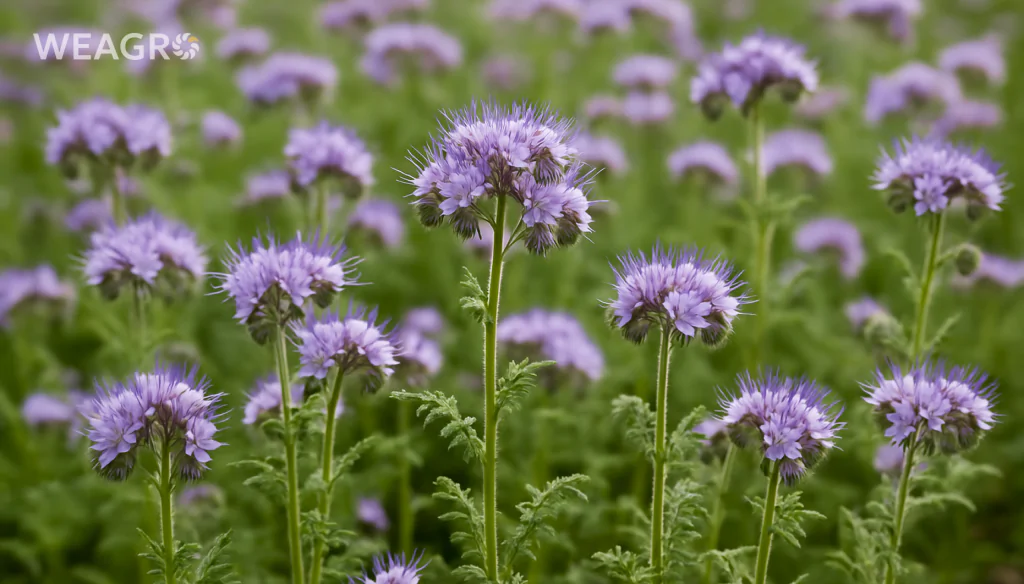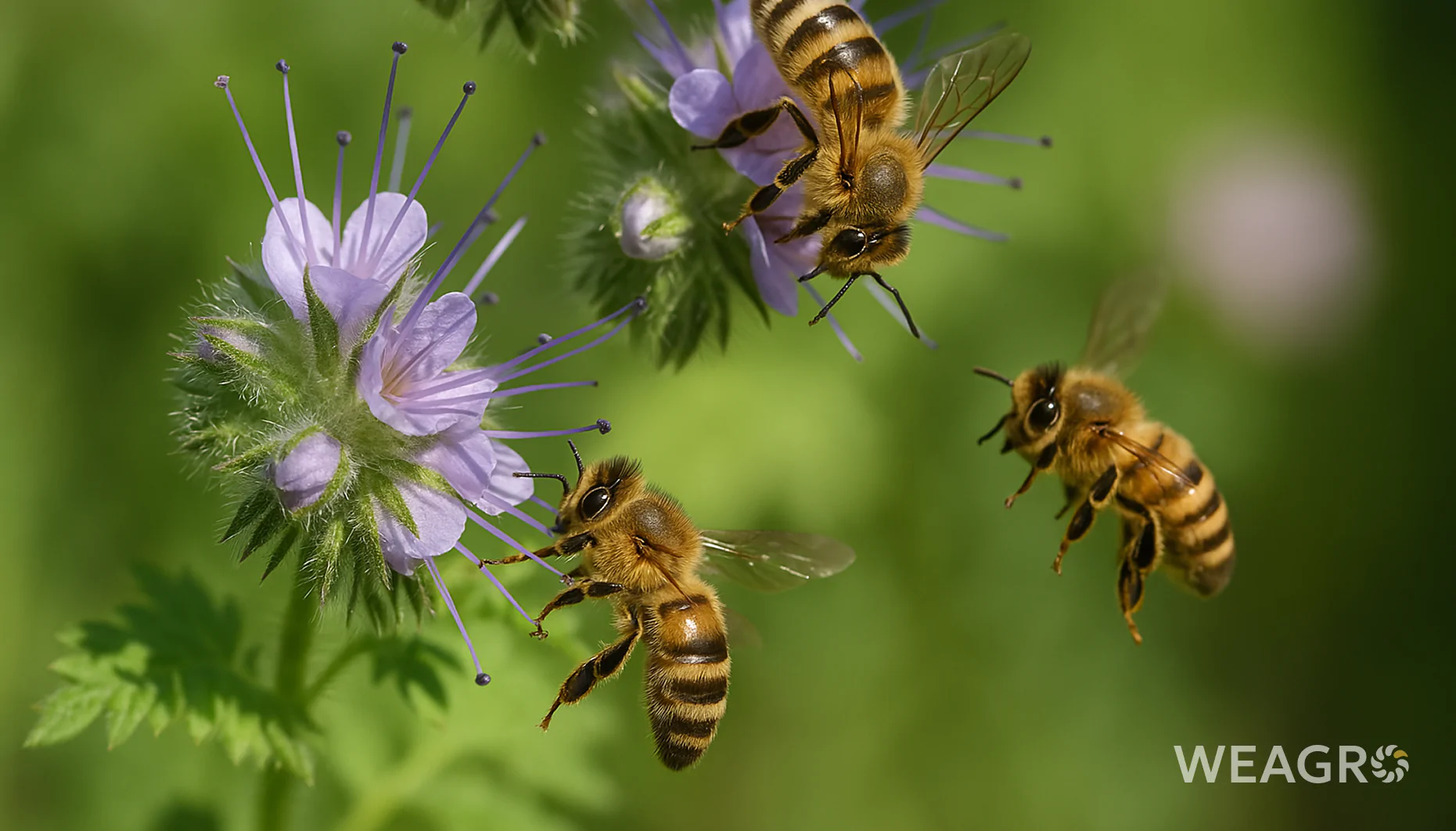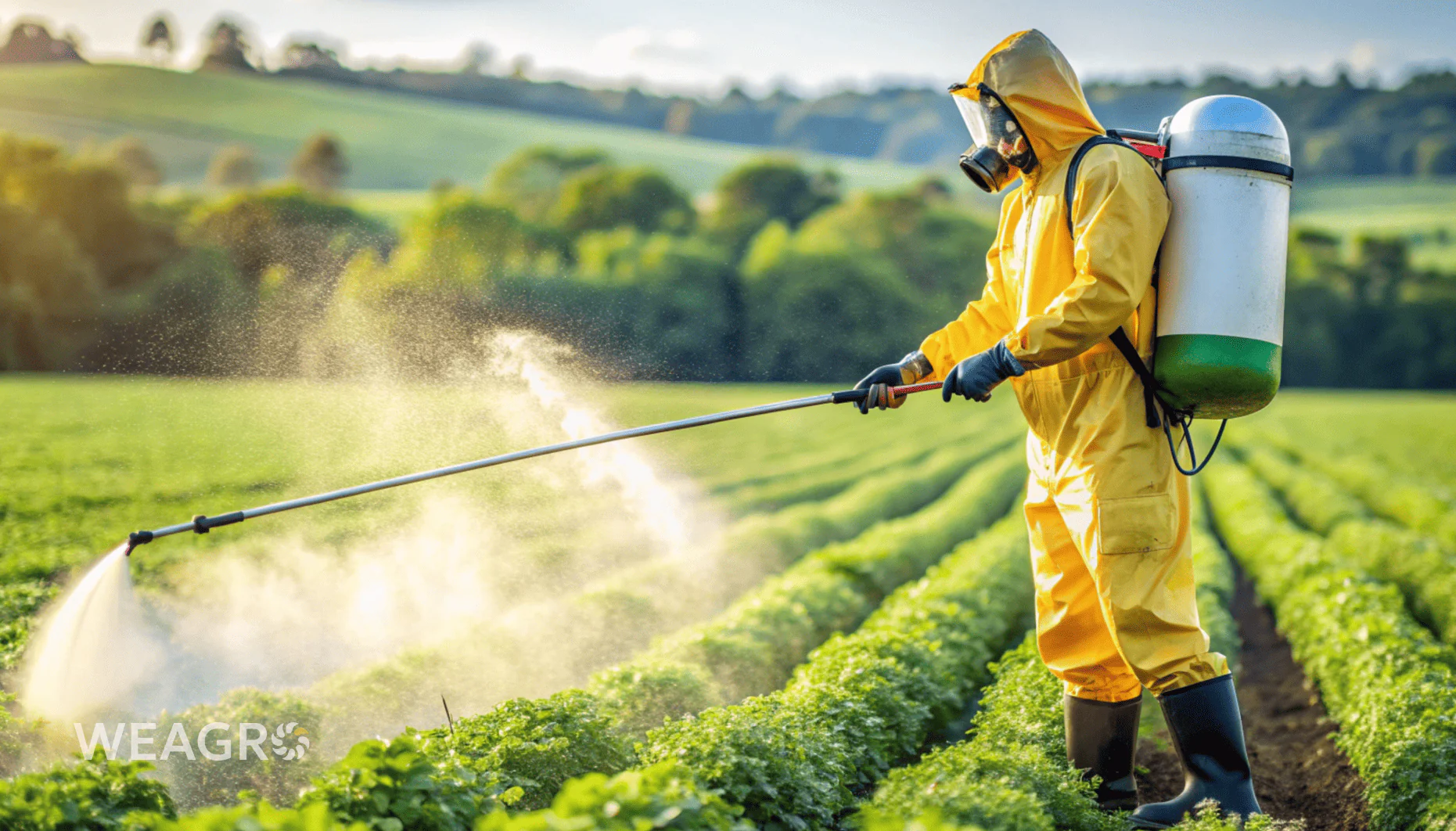Phacelia is a plant with versatile properties. It is used as a green manure to improve soil structure and fertility, as a honey plant for beekeeping, and as livestock feed. In this article, we will examine in detail when to sow phacelia, which cultivation technology to choose depending on the purpose, and how to get the maximum benefit from this versatile crop in Ukrainian agribusiness conditions.
Phacelia: Crop Characteristics
Phacelia is an annual herbaceous plant with an upright branched stem 50-120 cm tall. Its leaves are pinnately dissected and alternate. The flowers are small, blue or purple, gathered in scorpioid cyme inflorescences. The fruit is a multi-seeded capsule. The root system is taproot, penetrating to a depth of up to 2 meters.
The vegetation period of the “bee plant” is 75-90 days. Seedlings appear on the 7th-10th day. Flowering begins after 40-50 days and lasts about a month. Under favorable conditions, phacelia can produce 2-3 cuts of green mass per season.
The plant is very light-loving and responds well to long daylight hours. With insufficient lighting, the crops stretch out and yield decreases. The optimal temperature for growth and development is 18-25°C. Seeds begin to germinate at 4-5°C, and adult plants can withstand frosts down to -5…-7°C.
Phacelia as a green manure is moisture-loving and grows best at soil moisture of 70-80% field capacity. In dry conditions, growth slows down and leafiness decreases. The critical period for moisture is budding and flowering. To form 1 ton of dry matter, the ameliorative crop uses about 700 tons of water.
Read also: Vegetation Indices in Agriculture: NDVI, NDRE, MSAVI, NDMI
Why Plant Phacelia
Phacelia is grown for several purposes:
- As a green manure crop. Thanks to its powerful root system and large green mass, the grass enriches the soil with organic matter, improves its structure and fertility. When plowing in the green mass, the crop serves as an effective fertilizer. During vegetation, phacelia as a green manure accumulates 15-20 t/ha of green mass, which is equivalent to applying 30-40 t/ha of manure.
- Phacelia as a honey plant. From 1 ha of pollen-bearing crops, up to 300 kg of honey can be obtained. The flowering continues for about a month, providing a long honey flow. Honey from phacelia for beekeeping is light, transparent, aromatic, and has high taste and medicinal properties.
- As a fodder crop. The green mass of the grass contains a lot of protein (up to 20%), as well as ascorbic acid, carotene, and minerals. 100 kg contains about 14-16 feed units. Phacelia as feed for rabbits is used fresh, as well as for making silage, hay, and grass meal. The green mass is readily eaten by cattle, horses, rabbits, and poultry.
- As a phytosanitary crop. The soil improver has allelopathic properties, suppressing weed growth. The plant is resistant to pests and diseases, and is little affected by nematodes. Including phacelia in crop rotation improves it, reducing the spread of disease pathogens and pests.
Due to symbiotic nitrogen fixation, the grass accumulates 80-100 kg/ha of nitrogen, which is equivalent to applying 15-20 t/ha of manure. On poor soils, phacelia increases humus content up to 0.3-0.4%. The developed root system of the plants loosens and structures the soil to a significant depth.
Where Phacelia is Grown
Phacelia cultivation is possible in all climatic zones of Ukraine. It is undemanding to soil quality and condition, capable of germinating even in conditions unsuitable for agricultural crops – in sandy, podzolic, eroded soils. It grows well with different mechanical compositions, acidity, moisture supply, or nutrient availability.
The main growing regions in Ukraine are the Forest-Steppe and Polissya. In the Forest-Steppe zone, the crop is used as high-protein livestock feed, green manure, and honey plant. It is suitable for cultivation in the zone of risky agriculture. In Polissya, it is sown mainly as a green manure to improve soil fertility and as a honey plant to support beekeeping.
In southern regions, the phytomeliorant is grown in limited quantities due to high summer temperatures and drought threat. When sown in autumn or early spring, the crop manages to form a yield before the heat sets in. Irrigation is needed here to obtain high yields.
The distribution area of phacelia covers most European countries, North America, Japan, and Australia. The plant adapts well to different conditions and is undemanding in terms of agricultural technology.
Phacelia Cultivation Technology

To obtain a good harvest, certain agronomic rules must be followed. Let’s look at how to sow phacelia, as well as the main stages of growing this crop.
Phacelia Yield
Under favorable conditions, the yield of green mass can reach 30-50 t/ha. For seeds, 0.5-0.7 t/ha is harvested. Honey productivity is 100-300 kg/ha, and in some years reaches 500-600 kg/ha.
The number of seedlings depends on soil moisture, nutrient availability, and sowing density. To obtain high results, optimal conditions must be created throughout the entire vegetation period.
The grass gives the best yields in fertile soils with full mineral nutrition. When sown in pure form, the amount of green mass is higher than in mixtures. Early sowing dates also provide higher productivity than late ones.
When growing as green fodder and green manure, cuts should be made in the budding phase – beginning of flowering. At this time, plants accumulate the most vegetative mass of high feed value. If cutting is delayed, stems become coarser, leaves fall off, and feed quality deteriorates.
Phacelia: Growing Conditions
The phytomeliorant is undemanding to growing conditions, but grows best in fertile, well-aerated soils with neutral or slightly acidic reaction. Heavy clay, waterlogged, acidic soils are unsuitable for cultivation. The grass responds well to liming and gypsum application.
Read also: How to Determine Soil Acidity and How to Lower or Increase It
Plants poorly tolerate excessive moisture and water stagnation – seeds rot, seedlings thin out. The optimal soil moisture is 70-80% field capacity. The critical period for moisture is flowering. Lack of water during this time leads to flower and ovary drop, significant shortfall in seed yield, as well as green mass.
In Ukraine, the crop can be grown in all natural-climatic zones. In the south, it is sown in autumn or late winter, in other regions – in spring, after the frost threat has passed. The optimal temperature for seed germination is 10-12°C. Seedlings can withstand frosts down to -5°C.
The pollen-bearer is very light-loving; in case of shading, it stretches out and yield decreases. Therefore, it should not be sown under the cover of other crops or in dense sowings. For mechanical mixtures, components should be selected so that they do not suppress the flowers.
Phacelia: Sowing
Before sowing, the field needs to be carefully prepared. Let’s look at the main stages of the campaign and phacelia cultivation technologies.
When to Sow Phacelia
So, when to sow phacelia? In most of Ukraine, the crop is sown in early spring: late April – early May, when the soil warms up to 8-10°C. In southern regions, sowing is possible in winter – in October-November, or early spring, on frozen-thawed soil.
When grown as a green manure, the grass can be sown in several periods from early spring to late autumn. When sown for winter, plants grow well in spring, quickly building up green mass. Late sowings in September-October allow accumulating a rosette of leaves by winter, which will decompose and fertilize the soil.
For honey plants, phacelia is sown in May-June to ensure flowering during the active honey collection period – in July-August. Repeated sowings every 20-30 days allow extending the flowering period until late autumn.
Soil Preparation for Phacelia Sowing
Soils for cultivation should be clean from weeds, leveled, and loosened. Processing depends on the predecessor and soil condition. After stubble, disking and autumn plowing are carried out, depth – 20-22 cm. During main tillage, organic fertilizers are applied at a rate of 20-30 t/ha of manure or compost.
In spring, moisture is retained, soil is leveled and loosened with cultivators and harrows. To destroy weeds before sowing, 1-2 pre-sowing harrowings can be carried out, preferably diagonally to the future sowing.
Organic matter is applied during main tillage or pre-sowing cultivation. The optimal solution is to use compost, humus, or green manure from previous green manures at a rate of 15-25 t/ha. When growing as a phytomeliorant, organic matter rates are reduced or not applied at all, as phacelia itself is a green manure. On poor soils, biohumus or compost with added ash can be used to enrich with potassium and phosphorus of natural origin.
The online service WEAGRO provides agricultural producers with the opportunity to purchase fertilizers for phacelia seeds and other green manure crops with deferred payment, without collateral and unnecessary documents. This allows optimizing financial resources to sow on time.
Phacelia Predecessors
The best predecessors are crops that free up the field early – winter or spring cereals, legumes, potatoes, corn as green fodder. It’s not advisable to sow the plant after perennial legume grasses like alfalfa, clover, sainfoin due to common pests.
Phacelia itself is an excellent predecessor for most crops in rotation. It frees up the field early, leaving soil clean from weeds with a large amount of crop-root residues. As a green manure that is plowed into the soil, the phytomeliorant improves its structure, increases organic matter content, NPK.
The best subsequent crops after phacelia are row crops and vegetables: potatoes, corn, beets, cabbage, tomatoes. Winter cereals – wheat, rye, barley – also grow well. Returning the grass to the previous field is recommended no earlier than 3-4 years to prevent accumulation of pests and disease pathogens.
Read also: Sugar Beet: Sowing, Yield, Varieties, and Diseases
Phacelia Seeding Rate
Phacelia seeding rates depend on the intended purpose and sowing method:
- green fodder and green manure – 10-14 kg/ha for ordinary row sowing, 8-10 kg/ha for wide-row sowing;
- seeds – 8-10 kg/ha for ordinary row sowing, 6-8 kg/ha for wide-row sowing;
- in mixtures with other crops – 6-8 kg/ha.
When sowing, it is necessary to use conditioned seeds not lower than 2nd class of sowing standard. Seeds are treated before sowing. To increase field germination and germination energy, it is recommended to perform incrustation or bubbling.
Crop Sowing Method
Phacelia can be sown both by ordinary row and wide-row methods. Row sowing is carried out with grain seeders with 15 cm row spacing. It provides uniform plant placement on the area.
Wide-row sowing method with 30-45 cm row spacing is used on fields clean from weeds. It facilitates crop care but slightly reduces green mass yield. Row-crop seeders are used for sowing.
Seed embedding depth on heavy soils is 1.5-2 cm, on light soils – 3-4 cm. After sowing, the field is rolled with ring-spur rollers, which improves seed contact with soil and accelerates seedling emergence. For early spring sowing, rolling is better done before and after sowing.
Phacelia Care
The main care for crops consists of protection from weeds, pests, diseases and ensuring moisture. After emergence, if necessary, harrowing is carried out with light or medium harrows across the rows. On wide-row sowings, inter-row loosening is mandatory, recommended depth – 6-8 cm.
In conditions of insufficient moisture, 1-2 moisture-charging irrigations are carried out with a norm of 300-500 m³/ha. Moisture is saturated by furrow flooding or sprinkling. On seed crops in the budding and flowering phase, if necessary, refreshing irrigations are made with a norm of 150-200 m³/ha.
To form 1 ton of seeds, phacelia uses a significant amount of nutrients. To provide plants with necessary elements in organic farming, compost, humus, bird droppings or biohumus are used. Fertilizing is carried out with diluted infusion (1:10) at a rate of 2-3 l/m² or dry compost (3-5 kg/10 m²). They are applied superficially before rain or with subsequent light rolling and mulching. It is effective to use compost tea or organic biopreparations based on beneficial microorganisms, which improve nutrient absorption from the soil.
When grown as green fodder, cuts are made in the budding phase or at the beginning of flowering. Plants are mowed at a height of 5-6 cm with mowers or scythes. To obtain seeds, crops are harvested by the separate method when 70-75% of capsules turn brown. Swaths are dried for 3-5 days and threshed by combine.
When Phacelia is Harvested

So, how many days does it take for phacelia to emerge? Seedlings appear on the 7th-10th day. As green fodder, the grass begins to be mowed at the beginning of flowering, when plants reach a height of 50-70 cm. At this period, the mass has an optimal ratio of leaves and stems, contains the most nutrients.
For hay use, the first cut is made in the budding phase, subsequent ones – when plants regrow to 40-50 cm. Under favorable conditions, 2-3 cuts can be harvested with a yield of 150-200 c/ha of green mass.
As a seed crop, it is harvested when 75-80% of capsules turn brown by direct combining. Timeliness prevents seed shattering. The harvested seeds are immediately cleaned, sorted and dried to 12-14% moisture before storage.
Conclusion
Phacelia is a valuable fodder, honey, and green manure crop, the cultivation of which is gaining popularity in Ukraine. It is undemanding to conditions, well cleans and enriches the soil, attracts bees, provides nutritious feed for livestock.
To increase cultivation efficiency, it is advisable to use modern crop monitoring technologies, including satellite imagery-based agricultural insurance systems and weather stations. This allows for monitoring plant conditions, timely problem detection, and cost reduction.
The online service WEAGRO helps agricultural producers implement innovative solutions and optimize financial resources. You can purchase seeds, fertilizers, and plant protection products with deferred payment, without collateral and excessive paperwork.









